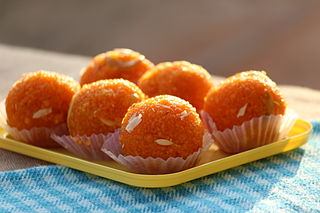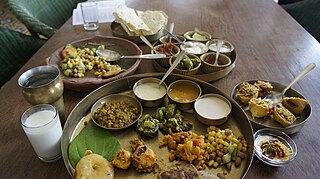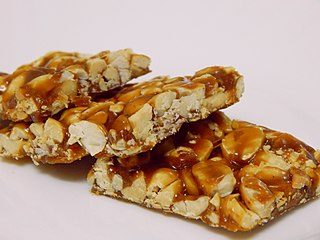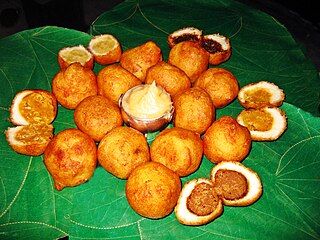
Rice pudding is a dish made from rice mixed with water or milk and commonly other ingredients such as sweeteners, spices, flavourings and sometimes eggs.

Gulab jamun is a sweet confectionary or dessert, originating in the Indian subcontinent and a type of mithai popular in India, Pakistan, Nepal, the Maldives and Bangladesh, as well as Myanmar. It is also common in nations with substantial populations of people with South Asian heritage, such as Mauritius, Fiji, Gulf states, the Malay Peninsula, Great Britain, South Africa, and the Caribbean countries of Jamaica, Trinidad and Tobago, Guyana, and Suriname.

Laddu or laddoo is a spherical sweet from the Indian subcontinent made of various ingredients and sugar syrup or jaggery. It has been described as "perhaps the most universal and ancient of Indian sweets."

Barfi or burfi is a milk-based sweet from the Indian subcontinent with a fudge-like consistency. Its name comes from the Persian and Urdu word (barf) for snow. Barfi is consumed throughout India and Pakistan and is especially popular in North India. It is often served at celebrations and religious festivals such as Diwali and Holi.

Puran poli is an Indian sweet flatbread that is popular in South India and the state of Maharashtra. It is also known as Puran puri, Holige, Obbattu, Bobbattlu, Poley, Bakshamulu, and Boli.
Mithai (sweets) are the confectionery and desserts of the Indian subcontinent. Thousands of dedicated shops in India, Bangladesh, Nepal, Pakistan and Sri Lanka sell nothing but sweets.

Gujarati cuisine is the cuisine of the Indian state of Gujarat. The typical Gujarati thali consists of rotli, dal or curry, rice, and shaak. The thali will also include preparations made from pulses or whole beans such as moong, black eyed beans etc., a snack item (farsaan) like dhokla, pathra, samosa, fafda, etc. and a sweet (mishthaan) like mohanthal, jalebi, sevaiya etc.

Indian breads are a wide variety of flatbreads and crêpes which are an integral part of Indian cuisine. Their variation reflects the diversity of Indian culture and food habits.

Sindhi cuisine refers to the distinct native cuisine of the Sindhi people from Sindh, Pakistan. Sindhi cuisine has been influenced by Central Asian, Iranian, Mughal food traditions. It is mostly a non-vegetarian cuisine, with even Sindhi Hindus widely accepting of meat consumption. The daily food in most Sindhi households consists of wheat-based flat-bread (Mani) or rice accompanied by two dishes, one gravy and one dry with curd, papad or pickle. Freshwater fish and a wide variety of vegetables are usually used in Sindhi cuisine. Restaurants specializing in Sindhi cuisine are rare, although it is found at truck stops in rural areas of Sindh province, and in a few restaurants in urban Sindh.

Chikki is a traditional Indian sweet (brittle) generally made from nuts and jaggery/sugar. There are several different varieties of chikki in addition to the most common groundnut (peanut) chikki. Each variety of chikki is named after the ingredients used, which include puffed or roasted Bengal gram, sesame, puffed rice, beaten rice, or khobra, and other nuts such as almonds, cashews and pistachios.

Pithas are a variety of food similar to pancakes, dumplings or fritters, originating from the Indian subcontinent, common in Bangladesh and India. Pitha can be sweet or savoury, and usually made from a dough or batter, which is then steamed, fried or griddled. Very few varieties are oven-baked or boiled, and most are unleavened and cooked on a stovetop. Some versions may have a filling, garnish, or sauce. Few may be set or shaped after cooking. They are typically eaten as a snack with chai, or as treats during special occasions.
Bhojpuri cuisine is a style of food preparation common among the Bhojpuri people of Bihar and eastern Uttar Pradesh in India, and also the Terai region of Nepal. Bhojpuri foods are mostly mild and tend to be less hot in terms of spices used. The cuisine consists of both vegetable and meat dishes.

Poha, also known as pohe, aval, pauwa, sira, chira, chivda, or avalakki or baji, among many other names, is flattened rice originating from the Indian subcontinent. Rice is parboiled before flattening so that it can be consumed with very little to no cooking. These flakes of rice swell when added to liquid, whether hot or cold, as they absorb water, milk or any other liquids. The thickness of the flakes varies from almost translucently thin to nearly four times thinner than a normal rice grain.

Ariselu or Arisa is an Indian sweet from Andhra Pradesh, Odisha, Telangana. It is also called Kajjaya in Kannada, Adhirasam in Tamil Nadu, Neyyappam in Kerala ,Anarsa in Marathi, arsa or anarsa in Uttarakhand, Bihar and Jharkhand.

Gujhia, also known as Gughara, Pedakiya, Purukiya, Karanji, Kajjikayalu, Somas, and Karjikayi, is a sweet, deep-fried pastry that is a popular dessert in the Indian subcontinent. This delicacy is made using either suji (semolina) or maida, which is stuffed with a mixture of sweetened khoa and dried fruits. The dumpling is then fried in ghee to give it a crispy texture.

Adhirasam, kajjaya or athrasa in Kannada, ariselu in Telugu, anarasa in Marathi, Airsa in Chhattisgarhi or Arisa pitha in Odia) is a type of Indian sweet made out of rice, jaggery, ghee and sometimes coconut and with spices like cardamom, sesame, pepper and ginger powder from Tamil cuisine, Karnataka cuisine, Telugu cuisine, Marathi cuisine and Odia cuisine. The doughnut-like fried dough has a long history of popularity in Kannada, Telugu, Maharashtra, Chhattisgarh, Odisha, and Tamil civilization. They are similar in shape to vada, but are not savoury and are eaten as a sweet.

Boorelu is an Indian sweet and dumpling made of rice flour stuffed with jaggery mixed dal paste and dry fruits. It is often served hot with ghee. It is called poornam in Telangana and Andhra Pradesh. Poornam preparation follows the traditional methods common to all South Indian cuisines. Poornam Boorelu are traditionally prepared using a rice-urad dal batter, and then packed with some shredded dry fruits and channa dal mixture known as poornam and it is then deep-fried in oil until golden brown.

Andhra cuisine, culturally known as Telugu cuisine, is a cuisine of India native to the state of Andhra Pradesh and is the culinary style of Telugu people. It is generally known for its tangy, hot, and spicy taste.

Suji ka Halwa is a type of halvah made by toasting semolina in a fat like ghee or oil, and adding a sweetener like sugar syrup or honey or even jaggery powder. It can be served for breakfast or as a dessert item. The basic recipe is made with just semolina, sugar or honey, ghee, and sometimes milk. Variations on this include dried or fresh fruits, nuts, shredded coconut, and other toppings.


















